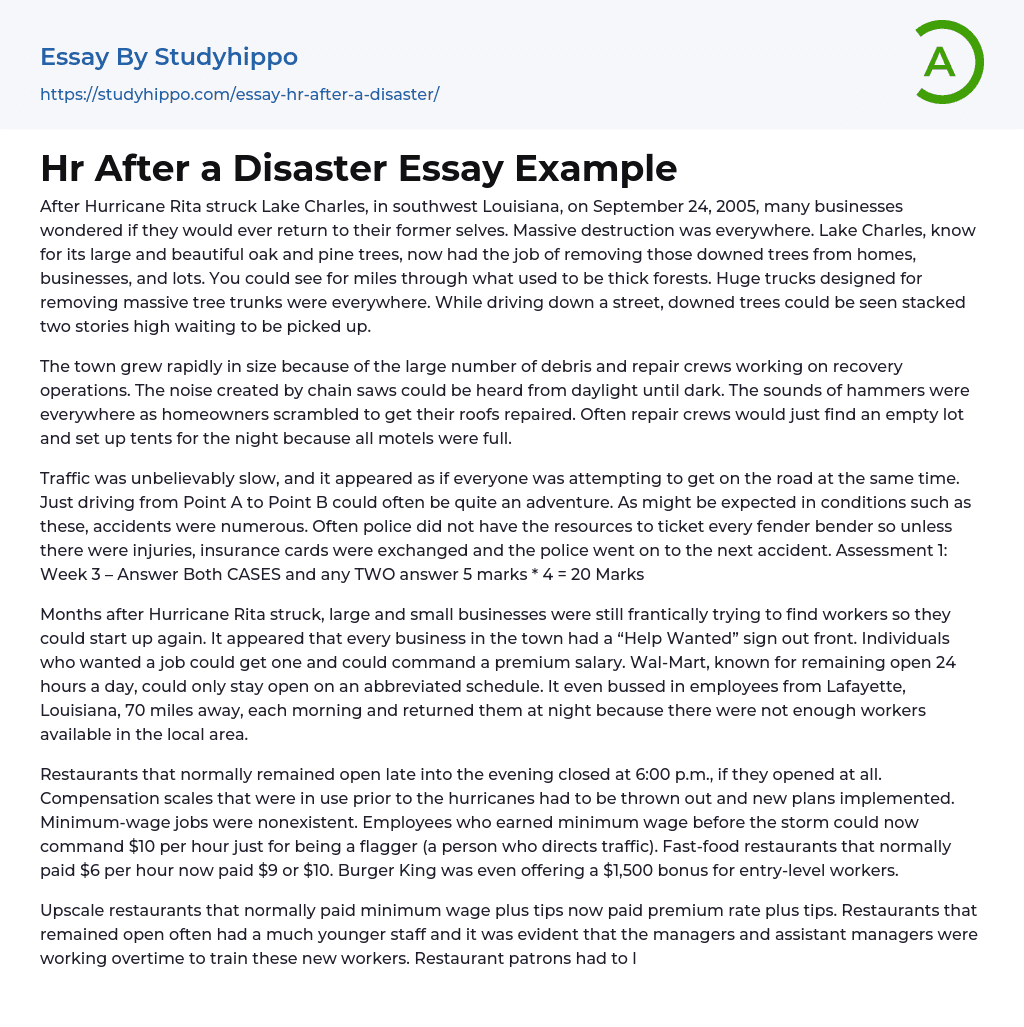After Hurricane Rita struck Lake Charles, in southwest Louisiana, on September 24, 2005, many businesses wondered if they would ever return to their former selves. Massive destruction was everywhere. Lake Charles, know for its large and beautiful oak and pine trees, now had the job of removing those downed trees from homes, businesses, and lots. You could see for miles through what used to be thick forests. Huge trucks designed for removing massive tree trunks were everywhere. While driving down a street, downed trees could be seen stacked two stories high waiting to be picked up.
The town grew rapidly in size because of the large number of debris and repair crews working on recovery operations. The noise created by chain saws could be heard from daylight until dark. The soun
...ds of hammers were everywhere as homeowners scrambled to get their roofs repaired. Often repair crews would just find an empty lot and set up tents for the night because all motels were full.
Traffic was unbelievably slow, and it appeared as if everyone was attempting to get on the road at the same time. Just driving from Point A to Point B could often be quite an adventure. As might be expected in conditions such as these, accidents were numerous. Often police did not have the resources to ticket every fender bender so unless there were injuries, insurance cards were exchanged and the police went on to the next accident. Assessment 1: Week 3 – Answer Both CASES and any TWO answer 5 marks * 4 = 20 Marks
Months after Hurricane Rita struck, large and small businesses wer
still frantically trying to find workers so they could start up again. It appeared that every business in the town had a “Help Wanted” sign out front. Individuals who wanted a job could get one and could command a premium salary. Wal-Mart, known for remaining open 24 hours a day, could only stay open on an abbreviated schedule. It even bussed in employees from Lafayette, Louisiana, 70 miles away, each morning and returned them at night because there were not enough workers available in the local area.
Restaurants that normally remained open late into the evening closed at 6:00 p.m., if they opened at all. Compensation scales that were in use prior to the hurricanes had to be thrown out and new plans implemented. Minimum-wage jobs were nonexistent. Employees who earned minimum wage before the storm could now command $10 per hour just for being a flagger (a person who directs traffic). Fast-food restaurants that normally paid $6 per hour now paid $9 or $10. Burger King was even offering a $1,500 bonus for entry-level workers.
Upscale restaurants that normally paid minimum wage plus tips now paid premium rate plus tips. Restaurants that remained open often had a much younger staff and it was evident that the managers and assistant managers were working overtime to train these new workers. Restaurant patrons had to l
- Microbiology essays
- Bacteria essays
- Cell essays
- Enzyme essays
- Photosynthesis essays
- Plant essays
- Natural Selection essays
- Protein essays
- Viruses essays
- Cell Membrane essays
- Human essays
- Stem Cell essays
- Breeding essays
- Biotechnology essays
- Cystic Fibrosis essays
- Tree essays
- Seed essays
- Coronavirus essays
- Zika Virus essays
- Culture essays
- Social Control essays
- Citizenship essays
- Social Justice essays
- Caste System essays
- Social Responsibility essays
- Socialization essays
- Deviance essays
- Modern Society essays
- Popularity essays
- Civil Society essays
- Community essays
- Female essays
- Filipino People essays
- Igbo People essays
- Indigenous Australians essays
- Indigenous Peoples essays
- Minority Group essays
- Social Institution essays
- Men essays
- The nation essays
- Middle Class essays
- Social Norms essays
- Discourse Community essays
- Popular Culture essays
- Car Culture essays
- American Culture essays
- Mormon essays
- Indian Culture essays
- Mexican Culture essays
- Pop Culture essays




